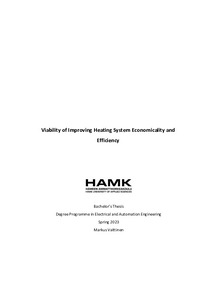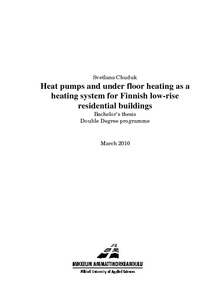Viability of Improving Heating System Economicality and Efficiency
Vaittinen, Markus (2023)
Vaittinen, Markus
2023
Julkaisun pysyvä osoite on
https://urn.fi/URN:NBN:fi:amk-2023060822973
https://urn.fi/URN:NBN:fi:amk-2023060822973
Tiivistelmä
Tämän opinnäytetyön tavoitteena oli arvioida eri lämmitysjärjestelmätyyppejä ja mahdollisia säästöjä, joita voidaan saavuttaa vaihtamalla olemassa olevasta järjestelmästä kokonaan toisentyyppiseen lämmitysjärjestelmään. Yksi tavoitteista oli luoda laskurityökalu, jolla voi vertailla erilaisten lämmitysjärjestelmien käyttökustannuksien eroja.
Jatkuvasti nouseva energian hinta ja uusien teknologioiden saatavuuden parantuminen ajavat maailmaa parantamaan järjestelmien ja laitteiden energiatehokkuutta ja taloudellisuutta. Uudet uusiutuvat energialähteet pystyvät kilpailemaan uusiutumattomien lähteiden kanssa, sillä vaikka niiden käyttöön ottamisen hinta saattaa olla suurempi, niiden käyttökustannukset ovat yleisesti alhaiset. Hiilineutraalisuustavoitteet ja polttonesteiden hintojen nouseminen ovat tällä hetkellä uhkaavia ongelmia erityisesti jokseenkin epävakaan maailmantilanteen vuoksi.
Tämä opinnäytetyö sisältää yleiskatsauksen lämmitysjärjestelmien taustateoriasta ja tietoa joistakin tietyistä lämmitysjärjestelmätyypeistä, lämmitysjärjestelmien toteuttamiseen liittyviä seikkoja, sekä luvun, joka esittelee lämmitysjärjestelmien vertailulaskinta ja sen tulosten analysointia.
Lämmitysjärjestelmän vaihtaminen toiseen voi parantaa rakennuksen lämmityksen taloudellisuutta ja tehokkuutta. Parannuksen suuruus riippuu siitä, mikä korvattava lämmitysjärjestelmä on, mikä lämmitysjärjestelmä korvaa vanhan järjestelmän, mikä on uuden järjestelmän resurssien saatavuus sillä hetkellä ja kuinka hyvin alkuperäinen lämmitysjärjestelmä on loppuviimeksi toteutettu ja optimoitu. Joskus teoreettinen tehokkuuden parannus ei saata olla riittävä kattaakseen lämmitysjärjestelmän vaihtamisen kustannuksia järkevällä aikavälillä. Tällöin on suoritettava monitorointia, optimointia ja modernisointia olemassa olevan järjestelmän parantamiseksi. The aim of this thesis was to evaluate different heating system types and the potential savings that could be achieved by switching from an existing system to a different type of heating system altogether. One of the objectives was to create a calculator tool that can be used to compare the operating costs of some different types of heating systems.
The ever-growing cost of energy and the increasing availability of new technologies are pushing the world to improve energy efficiency and economicality of systems and devices. New renewable sources are able to compete with non-renewable sources because even though the cost of implementing them might be greater, they have lower operating costs in-general. Carbon emission neutrality goals and the increased cost of fuels are pressing issues at current times, especially because of the somewhat unstable world situation.
This thesis contains an overview of the theory behind heating systems in-general and information about some of the specific heating systems types, considerations concerning the implementation of heating systems, and a chapter detailing a heating system comparison calculator and an analysis of its results.
Changing heating systems can definitely improve the economicality and efficiency of the heating in a building. The size of the improvement depends on what heating system is being replaced, what heating system is replacing the old system, what the availability of resources regarding the new system are at that time, and how well the original heating system was actually implemented and optimized. Sometimes the theoretical efficiency improvement may not be enough to repay the cost of the changing the heating system within a reasonable timeframe. In this case, monitoring, optimization, and modernization should be conducted in order to improve the existing system.
Jatkuvasti nouseva energian hinta ja uusien teknologioiden saatavuuden parantuminen ajavat maailmaa parantamaan järjestelmien ja laitteiden energiatehokkuutta ja taloudellisuutta. Uudet uusiutuvat energialähteet pystyvät kilpailemaan uusiutumattomien lähteiden kanssa, sillä vaikka niiden käyttöön ottamisen hinta saattaa olla suurempi, niiden käyttökustannukset ovat yleisesti alhaiset. Hiilineutraalisuustavoitteet ja polttonesteiden hintojen nouseminen ovat tällä hetkellä uhkaavia ongelmia erityisesti jokseenkin epävakaan maailmantilanteen vuoksi.
Tämä opinnäytetyö sisältää yleiskatsauksen lämmitysjärjestelmien taustateoriasta ja tietoa joistakin tietyistä lämmitysjärjestelmätyypeistä, lämmitysjärjestelmien toteuttamiseen liittyviä seikkoja, sekä luvun, joka esittelee lämmitysjärjestelmien vertailulaskinta ja sen tulosten analysointia.
Lämmitysjärjestelmän vaihtaminen toiseen voi parantaa rakennuksen lämmityksen taloudellisuutta ja tehokkuutta. Parannuksen suuruus riippuu siitä, mikä korvattava lämmitysjärjestelmä on, mikä lämmitysjärjestelmä korvaa vanhan järjestelmän, mikä on uuden järjestelmän resurssien saatavuus sillä hetkellä ja kuinka hyvin alkuperäinen lämmitysjärjestelmä on loppuviimeksi toteutettu ja optimoitu. Joskus teoreettinen tehokkuuden parannus ei saata olla riittävä kattaakseen lämmitysjärjestelmän vaihtamisen kustannuksia järkevällä aikavälillä. Tällöin on suoritettava monitorointia, optimointia ja modernisointia olemassa olevan järjestelmän parantamiseksi.
The ever-growing cost of energy and the increasing availability of new technologies are pushing the world to improve energy efficiency and economicality of systems and devices. New renewable sources are able to compete with non-renewable sources because even though the cost of implementing them might be greater, they have lower operating costs in-general. Carbon emission neutrality goals and the increased cost of fuels are pressing issues at current times, especially because of the somewhat unstable world situation.
This thesis contains an overview of the theory behind heating systems in-general and information about some of the specific heating systems types, considerations concerning the implementation of heating systems, and a chapter detailing a heating system comparison calculator and an analysis of its results.
Changing heating systems can definitely improve the economicality and efficiency of the heating in a building. The size of the improvement depends on what heating system is being replaced, what heating system is replacing the old system, what the availability of resources regarding the new system are at that time, and how well the original heating system was actually implemented and optimized. Sometimes the theoretical efficiency improvement may not be enough to repay the cost of the changing the heating system within a reasonable timeframe. In this case, monitoring, optimization, and modernization should be conducted in order to improve the existing system.
Kokoelmat
Samankaltainen aineisto
Näytetään aineisto, joilla on samankaltaisia nimekkeitä, tekijöitä tai asiasanoja.
-
Heat pumps and under floor heating as a heating system for Finnish low-rise residential buildings
Chuduk, Svetlana (Mikkelin ammattikorkeakoulu, 2010)In bachelor’s thesis the study of under floor heating system with ground source heat pump for the heat transfers fluid heating is considered. The case study is low-rise residential building in Finland with under floor ... -
Arrangement for recovering and utilizing the waste heat generated onboard a ship in district heating
Vuorinen, Otto (2021)The objective of the present Master’s thesis was to study the feasibility of an idea behind a Finnish patent to utilize the waste heat generated onboard a ship by it’s engines and to use it in an onshore application to ... -
District Heating Rehabilitation in Russia : The hydro-ejector system's replacement with the plate heat exchanger
Vuorensola, Jussi (Oulun ammattikorkeakoulu, 2015)This thesis has two assigners. The first one is Karelia institute, which wanted more information about the hydro-ejector's functions and Russian heating norms. Besides of that Jupra Oy, which wanted to find out about ...



